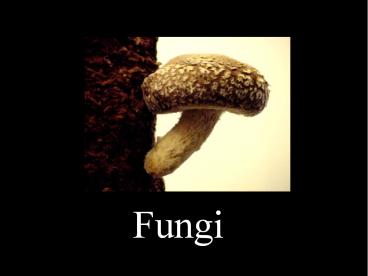Fungi - PowerPoint PPT Presentation
1 / 21
Title:
Fungi
Description:
Fungi Basic Information: Fungi are... - eukaryotes - mostly multicellular - sometimes unicellular (yeast) - very diverse with an estimated 1.5 million species ... – PowerPoint PPT presentation
Number of Views:197
Avg rating:3.0/5.0
Title: Fungi
1
Fungi
2
Basic Information Fungi are... - eukaryotes -
mostly multicellular - sometimes unicellular
(yeast) - very diverse with an estimated 1.5
million species - widely spread, having colonized
most terrestrial habitats
3
Evolutionary History
- Fungi likely evolved from an aquatic,
unicellular, flagellated protist 1.5 billion
years ago. - All the oldest fungi
fossils are 460 million years old. Perhaps
microscopic fungal ancestors fossilized poorly.
4
- Systematists recognize Fungi and Anamalia as
sister kingdoms - Animals, fungi, and their
closest common ancestor are opisthokonts - Most
fungal diversity may have come from adaptive
radiation with land colonization.
5
Body Structures - Hyphae are a network of tiny
filaments composed of tubular cell walls. -
Mycelia are interwoven hyphae that surround and
penetrate nutrient sources.
- Hyphae are made of chitin. - Specialized hyphae
for penetrating hosts called haustoria.
6
Body Structures - Septa are cross walls with
pores large enough to allow nuclei through that
divide the hyphae into cells. - A fungus with
septa is septic and one without is coenocytic. -
In coenocytic fungi hyphae are continuous plasma
with up to thousands of nuclei.
7
Reproduction Asexual - Some fungi (molds) can
reproduce with spores, which are carried from the
parent by air/water.
- Molds grow quickly as mycelia, making spores.
- Fungi like yeasts can reproduce by mitosis. -
If a fungus has no known sexual stage, it is
called a deuteromycete.
8
Reproduction Sexual Sporing - Cells are haploid
with transient diploid stages. - Begins when
hyphae from two different mycelia release
pheramones, which bind to receptors. - Hyphae
extend toward each other and fuse. - Combining
the cytoplasm is called plasmogamy. - Nuclei do
not fuse instantly, so the mycelia contain
genetically different, coexisting nuclei. - This
makes it heterokaryotic. When nuclei pair off two
to a cell, it is dikaryotic.
9
- The amount of time between plasmogamy and
karyogamy can be hours or centuries. - In
karyogamy, nuclei fuse to form diploid cells,
which then go through meiosis. - The mycelia then
produce structures that disperse the new spores.
10
(No Transcript)
11
Chytrids (Chytridiomycota) - Live in soil and
lakes. - Both saprobes (decomposers) and parsites
of protists, plants, and animals. - Unicellular,
but occasionally form colonies with hyphae. -
Have flagellated spores (zoospores)
12
Zygomycetes (Zygomycota) - Phylum includes fast
growing molds, parasites, and commensal symbionts
of animals. - Coenozoic, with the exception of
reproductive cells (mostly asexual). - If sexual
reproduction occurs, a sturdy structure called
zygosporangium is produced. This is a zygote that
is multinucleate. - Zygosporangia are resistant
to many harsh conditions (i.e. freezing, dry). If
conditions become better, they undergo meiosis
and germinate.
13
Mutualistic Symbionts
- Mutualistic relationships between plants and
fungi where phosphate ions are exchanged for
nutrients are called mycorrhizae. -
Ectomycorrhizal fungi surround a root with hyphae
and grow into the extracellular spaces of the
root cortex. - Endomycorrihizal fungi grow into
the cells of the root.
14
(No Transcript)
15
Glomeromycetes (Glomeromycota)
- All glomeromycetes take part in a special type
of endomycorrhizae called arbuscular
mycorrhizae. - Hyphae extend into tiny tree-like
structures in the plant called arbuscules.
16
Ascomycetes (Ascomycota)
- Some are deadly plant pathogens, many are
saprobes, others are mutualistic symbionts, and
some are even pesticides. - Defining feature of
phylum is sexual spores in saclike asci. - Sexual
stages are in fruiting bodies called ascocarps. -
Usually reproduce asexually using large numbers
of spores called conidia.
17
Basidiomycetes (Basidiomycota)
- Named for basidium, a cell in which there is a
transient diploid stage. - Saprobes, and mostly
sexual reproducers. - Exists for long periods of
time as a dikaryotic mycelium, until as a result
of environmental stimuli, produces fruiting
bodies basidiocarps.
18
(No Transcript)
19
Lichens
-Lichens come from symbiotic bonds between fungi
and unicellular photosynthetic organisms like
green algae or cyanobacteria. - The fungi often
reproduce sexually, but lichen can produce
asexually as a unit, by either fragmentation or
soredia. - Soredia are clusters of hyphae full
of algae.
20
Ecological Significance
- Saprobes cycle nutrients. - Many fungi are
plant pathogens, but a couple protect plants from
insects. - Some fungal ailments effect animals
(mycosis) - Many plants could not grow without
the mutualistic relationships they share with
fungi.
21
Picture Citations http//www.ucmp.berkeley.edu/fu
ngi/chytrids.html http//news.softpedia.com/news/H
ow-Did-the-Fungi-Evolve-38697.shtml http//www.bot
any.hawaii.edu/faculty/wong/BOT135/Lect26.htm Wo
rks Cited Cummings, Benjamin, 7th edition.
Campbell Biology. New York Pearson,
1995-2011 "Ecological Roles". Tanelorn.
Accessed 11/16/11. Available Online
http//www.tanelorn.us/data/mycology/myc_eco.htm































